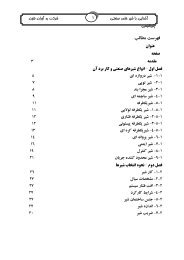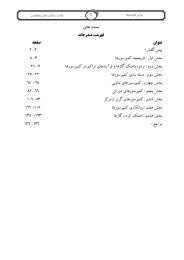- Page 1: http://www.Drshokuhi.comسایت آ
- Page 5: The Finite ElementMethodFifth editi
- Page 8 and 9: ContentsPrefacexv1. Some preliminar
- Page 10 and 11: Contentsix7.7 Concluding remarks 16
- Page 12 and 13: Contentsxi12.7 Stabilized methods f
- Page 15: Volume 2: Solid and structural mech
- Page 18 and 19: 1Some preliminaries: the standarddi
- Page 20 and 21: Table 1.1ENGINEERINGMATHEMATICSTria
- Page 22 and 23: and for the corresponding nodal dis
- Page 24 and 25: componentsf e " 08>:U iV iU nV nFin
- Page 26 and 27: The boundary conditions 9components
- Page 28 and 29: Electrical and ¯uid networks 11jP
- Page 30 and 31: The general pattern 131 2(a)2 313 4
- Page 32 and 33: Transformation of coordinates 15Onl
- Page 34 and 35: 10. R.W. Clough. The ®nite element
- Page 36 and 37: Direct formulation of ®nite elemen
- Page 38 and 39: Direct formulation of ®nite elemen
- Page 42 and 43: Direct formulation of ®nite elemen
- Page 44 and 45: Generalization to the whole region
- Page 46 and 47: Displacement approach as a minimiza
- Page 48 and 49: Convergence criteria 312.5 Converge
- Page 50 and 51: Displacement functions with discont
- Page 52 and 53: The above energy expression is alwa
- Page 54 and 55: and the sti€ness matrices for the
- Page 56 and 57: 3Generalization of the ®nite eleme
- Page 58 and 59: Introduction 41then the approximati
- Page 60 and 61: If the boundary conditions (3.12) a
- Page 62 and 63: Integral or `weak' statements equiv
- Page 64 and 65: Approximation to integral formulati
- Page 66 and 67: Approximation to integral formulati
- Page 68 and 69: Approximation to integral formulati
- Page 70 and 71: Virtual work as the `weak form' of
- Page 72 and 73: In the ®rst set of bracketed terms
- Page 74 and 75: Here the expression for K ij is ide
- Page 76 and 77: Convergence 59In other examples of
- Page 78 and 79: What are `variational principles'?
- Page 80 and 81: `Natural' variational principles an
- Page 82 and 83: `Natural' variational principles an
- Page 84 and 85: Establishment of natural variationa
- Page 86 and 87: To test for symmetry with any two f
- Page 88 and 89: Constrained variational principles.
- Page 90 and 91:
Constrained variational principles.
- Page 92 and 93:
Constrained variational principles.
- Page 94 and 95:
Constrained variational principles.
- Page 96 and 97:
This minimum is obviously zero at t
- Page 98 and 99:
Constrained variational principles.
- Page 100 and 101:
Table 3.2 Finite element approximat
- Page 102 and 103:
6. Also attributed to Bubnov, 1913:
- Page 104 and 105:
4Plane stress and plane strain4.1 I
- Page 106 and 107:
Element characteristics 89in whicha
- Page 108 and 109:
and the initial strains as8>:" x0"
- Page 110 and 111:
Element characteristics 93for plane
- Page 112 and 113:
Element characteristics 95To obtain
- Page 114 and 115:
Examples ± an assessment of perfor
- Page 116 and 117:
Examples ± an assessment of perfor
- Page 118 and 119:
y521004910047CBA48100xRestrained in
- Page 120 and 121:
Some practical applications 103012-
- Page 122 and 123:
-300+200Arrow indicatestension-9220
- Page 124 and 125:
Some practical applications 107Temp
- Page 126 and 127:
yx250000 lb/ft 2Indicates tensionFi
- Page 128 and 129:
References 1114.6 Concluding remark
- Page 130 and 131:
Element characteristics 113z (v)mij
- Page 132 and 133:
Element characteristics 115With the
- Page 134 and 135:
Element characteristics 117Writing
- Page 136 and 137:
Element characteristics 119or notin
- Page 138 and 139:
Some illustrative examples 1215.2.9
- Page 140 and 141:
Early practical applications 123In
- Page 142 and 143:
Axisymmetry ± plane strain and pla
- Page 144 and 145:
6Three-dimensional stress analysis6
- Page 146 and 147:
Tetrahedral element characteristics
- Page 148 and 149:
in which23@N i@x ; 0; 0@N0; i@y ; 0
- Page 150 and 151:
Tetrahedral element characteristics
- Page 152 and 153:
Examples and concluding remarks 135
- Page 154 and 155:
Prestressing Concretesystem E = 5 x
- Page 156 and 157:
References 139generated mesh with a
- Page 158 and 159:
7.2 The general quasi-harmonic equa
- Page 160 and 161:
Finite element discretization 143Eq
- Page 162 and 163:
Some economic specializations 145Wi
- Page 164 and 165:
Examples ± an assessment of accura
- Page 166 and 167:
in which is the stress function, G
- Page 168 and 169:
Some practical applications 151H =
- Page 170 and 171:
Some practical applications 1531234
- Page 172 and 173:
Some practical applications 15590ea
- Page 174 and 175:
Some practical applications 157we
- Page 176 and 177:
Some practical applications 1592.62
- Page 178 and 179:
References 161The free surface, bei
- Page 180 and 181:
32. J.H. Argyris, G. Mareczek, and
- Page 182 and 183:
Standard and hierarchical concepts
- Page 184 and 185:
Standard and hierarchical concepts
- Page 186 and 187:
Rectangular elements ± some prelim
- Page 188 and 189:
Completeness of polynomials 171yaa
- Page 190 and 191:
Rectangular elements ± Lagrange fa
- Page 192 and 193:
Rectangular elements ± `serendipit
- Page 194 and 195:
Elimination of internal variables b
- Page 196 and 197:
Triangular element family 179Fig. 8
- Page 198 and 199:
that contours of L 1 are equally pl
- Page 200 and 201:
The last shape again is a `bubble'
- Page 202 and 203:
Rectangular prisms ± `serendipity'
- Page 204 and 205:
Tetrahedral elements 18711(a) 4 nod
- Page 206 and 207:
ζ = 1123(a) 6 nodesζ4651121137102
- Page 208 and 209:
Hierarchic polynomials in one dimen
- Page 210 and 211:
Triangle and tetrahedron family 16;
- Page 212 and 213:
Triangle and tetrahedron family 16;
- Page 214 and 215:
Improvement of conditioning with hi
- Page 216 and 217:
15. J.G. Ergatoudis, B.M. Irons, an
- Page 218 and 219:
yη(x, y)(-1, 1) (1, 1)ηξξ(-1, -
- Page 220 and 221:
Use of `shape functions' in the est
- Page 222 and 223:
Use of `shape functions' in the est
- Page 224 and 225:
Variation of the unknown function w
- Page 226 and 227:
Consider,for instance,the set of lo
- Page 228 and 229:
Element matrices. Area and volume c
- Page 230 and 231:
Convergence of elements in curvilin
- Page 232 and 233:
Convergence of elements in curvilin
- Page 234 and 235:
Numerical integration ± one-dimens
- Page 236 and 237:
Numerical integration ± rectangula
- Page 238 and 239:
Numerical integration ± triangular
- Page 240 and 241:
Required order of numerical integra
- Page 242 and 243:
Required order of numerical integra
- Page 244 and 245:
Generation of ®nite element meshes
- Page 246 and 247:
In®nite domains and in®nite eleme
- Page 248 and 249:
In®nite domains and in®nite eleme
- Page 250 and 251:
In®nite domains and in®nite eleme
- Page 252 and 253:
Singular elements by mapping for fr
- Page 254 and 255:
Some practical examples of two-dime
- Page 256 and 257:
Three-dimensional stress analysis 2
- Page 258 and 259:
Three-dimensional stress analysis 2
- Page 260 and 261:
Three-dimensional stress analysis 2
- Page 262 and 263:
Symmetry and repeatability 245Analy
- Page 264 and 265:
References 24726. J. Peraire,M. Vah
- Page 266 and 267:
77. O.C. Zienkiewicz. Isoparametric
- Page 268 and 269:
Convergence requirements 251σ cons
- Page 270 and 271:
The simple patch test (tests Aand B
- Page 272 and 273:
Generalized patch test (test C) and
- Page 274 and 275:
10.5 The generality of a numerical
- Page 276 and 277:
Application of the patch test to pl
- Page 278 and 279:
Application of the patch test to pl
- Page 280 and 281:
(b)(a)(c)Fig. 10.9 Peculiar respons
- Page 282 and 283:
Application of the patch test to an
- Page 284 and 285:
Application of the patch test to an
- Page 286 and 287:
When a patch of elements is subject
- Page 288 and 289:
Table 10.3 Exact solution for patch
- Page 290 and 291:
Conclusion 2730-1Element size ln (h
- Page 292 and 293:
6. E.R. de Arantes Oliveira. The pa
- Page 294 and 295:
Introduction 277Clearly elimination
- Page 296 and 297:
Discretization of mixed forms ± so
- Page 298 and 299:
Stability of mixed approximation. T
- Page 300 and 301:
Stability of mixed approximation. T
- Page 302 and 303:
Two-®eld mixed formulation in elas
- Page 304 and 305:
Two-®eld mixed formulation in elas
- Page 306 and 307:
Here the stress interpolation is re
- Page 308 and 309:
Three-®eld mixed formulations in e
- Page 310 and 311:
Three-®eld mixed formulations in e
- Page 312 and 313:
functions yield a form8>:@N j@x@N j
- Page 314 and 315:
Three-®eld mixed formulations in e
- Page 316 and 317:
where…C ˆAt convergence the solu
- Page 318 and 319:
Complementary forms with direct con
- Page 320 and 321:
11.7.2 Solution using auxiliary fun
- Page 322 and 323:
8. R.S. Dunham and K.S. Pister. A
- Page 324 and 325:
12Incompressible materials,mixed me
- Page 326 and 327:
Two-®eld incompressible elasticity
- Page 328 and 329:
and is necessary for prevention of
- Page 330 and 331:
Two-®eld incompressible elasticity
- Page 332 and 333:
Three-®eld nearlyincompressible el
- Page 334 and 335:
Three-®eld nearlyincompressible el
- Page 336 and 337:
Reduced and selective integration a
- Page 338 and 339:
3 x 3 Gauss point integration2 x 2
- Page 340 and 341:
A simple iterative solution process
- Page 342 and 343:
A simple iterative solution process
- Page 344 and 345:
Stabilized methods for some mixed e
- Page 346 and 347:
Stabilized methods for some mixed e
- Page 348 and 349:
Since the approximations for " v an
- Page 350 and 351:
Stabilized methods for some mixed e
- Page 352 and 353:
Stabilized methods for some mixed e
- Page 354 and 355:
Stabilized methods for some mixed e
- Page 356 and 357:
Stabilized methods for some mixed e
- Page 358 and 359:
Stabilized methods for some mixed e
- Page 360 and 361:
perform well from those that do not
- Page 362 and 363:
References 34539. J.C. Simo and R.L
- Page 364 and 365:
Interface traction link of two (or
- Page 366 and 367:
Interface traction link of two or m
- Page 368 and 369:
which can be used directly in coupl
- Page 370 and 371:
We note that in the present de®nit
- Page 372 and 373:
Linking of boundary (or Trefftz)-ty
- Page 374 and 375:
Linking of boundary (or Trefftz)-ty
- Page 376 and 377:
Linking of boundary (or Trefftz)-ty
- Page 378 and 379:
13.7 Lagrange variables or disconti
- Page 380 and 381:
25. J.A. Ligget and P.L-F. Liu. The
- Page 382 and 383:
14Errors, recovery processes anderr
- Page 384 and 385:
De®nition of errors 367Similarly,
- Page 386 and 387:
5000300020001000500300200100NDF(0)4
- Page 388 and 389:
Superconvergence and optimal sampli
- Page 390 and 391:
which at an absolute minimum gives
- Page 392 and 393:
Recovery of gradients and stresses
- Page 394 and 395:
Superconvergent patch recovery ± S
- Page 396 and 397:
Superconvergent patch recovery ± S
- Page 398 and 399:
Superconvergent patch recovery ± S
- Page 400 and 401:
Recovery by equilibration of patche
- Page 402 and 403:
Error estimates by recovery 385and
- Page 404 and 405:
Other error estimators ± residual
- Page 406 and 407:
Integrating by parts, we can write
- Page 408 and 409:
Other error estimators ± residual
- Page 410 and 411:
Asymptotic behaviour and robustness
- Page 412 and 413:
Asymptotic behaviour and robustness
- Page 414 and 415:
Asymptotic behaviour and robustness
- Page 416 and 417:
11. O.C. Zienkiewicz and J.Z. Zhu.
- Page 418 and 419:
15Adaptive ®nite element re®nemen
- Page 420 and 421:
Introduction 403(a) Original mesh(b
- Page 422 and 423:
here we have used 36 jjejj 2 ˆjjuj
- Page 424 and 425:
Number of degrees of freedom10 30 5
- Page 426 and 427:
Some examples of adaptive h-re®nem
- Page 428 and 429:
Some examples of adaptive h-re®nem
- Page 430 and 431:
Some examples of adaptive h-re®nem
- Page 432 and 433:
p-re®nement and hp-re®nement 415E
- Page 434 and 435:
p-re®nement and hp-re®nement 417y
- Page 436 and 437:
p-re®nement and hp-re®nement 419P
- Page 438 and 439:
p-re®nement and hp-re®nement 421P
- Page 440 and 441:
p-re®nement and hp-re®nement 423y
- Page 442 and 443:
p-re®nement and hp-re®nement 425(
- Page 444 and 445:
12. L. Demkowiez, J.T. Oden, W. Rac
- Page 446 and 447:
16Point-based approximations;elemen
- Page 448 and 449:
Function approximation 431approxima
- Page 450 and 451:
Function approximation 433If we con
- Page 452 and 453:
Function approximation 435Table 16.
- Page 454 and 455:
Function approximation 4376644220(x
- Page 456 and 457:
Moving least square approximations
- Page 458 and 459:
whereandH…x† ˆXnk ˆ 1w k …x
- Page 460 and 461:
For example, the ®rst derivatives
- Page 462 and 463:
Hierarchical enhancement of moving
- Page 464 and 465:
Point collocation ± ®nite point m
- Page 466 and 467:
andX ni ˆ 1N p i …x n†u i ˆ g
- Page 468 and 469:
Galerkin weighting and ®nite volum
- Page 470 and 471:
Galerkin weighting and ®nite volum
- Page 472 and 473:
Galerkin weighting and ®nite volum
- Page 474 and 475:
Use of hierarchic and special funct
- Page 476 and 477:
where L i are the area coordinates
- Page 478 and 479:
Use of hierarchic and special funct
- Page 480 and 481:
Use of hierarchic and special funct
- Page 482 and 483:
6. J. Krok and J. Orkisz. A uni®ed
- Page 484 and 485:
55. W.K. Liu, S. Jun, S. Li, J. Ade
- Page 486 and 487:
Direct formulation of time-dependen
- Page 488 and 489:
Direct formulation of time-dependen
- Page 490 and 491:
Direct formulation of time-dependen
- Page 492 and 493:
Direct formulation of time-dependen
- Page 494 and 495:
form given byFree response ± eigen
- Page 496 and 497:
e developed. The discussion of such
- Page 498 and 499:
Free response ± eigenvalues for se
- Page 500 and 501:
Free response ± eigenvalues for se
- Page 502 and 503:
Forced periodic response 485and wri
- Page 504 and 505:
Transient response by analytical pr
- Page 506 and 507:
as for true eigenvectors a ia T i M
- Page 508 and 509:
References 491References1. S. Crand
- Page 510 and 511:
18The time dimension ± discreteapp
- Page 512 and 513:
Simple time-step algorithms for the
- Page 514 and 515:
Simple time-step algorithms for the
- Page 516 and 517:
Simple time-step algorithms for the
- Page 518 and 519:
Simple time-step algorithms for the
- Page 520 and 521:
Simple time-step algorithms for the
- Page 522 and 523:
Simple time-step algorithms for the
- Page 524 and 525:
10501000700Simple time-step algorit
- Page 526 and 527:
General single-step algorithms for
- Page 528 and 529:
General single-step algorithms for
- Page 530 and 531:
General single-step algorithms for
- Page 532 and 533:
General single-step algorithms for
- Page 534 and 535:
General single-step algorithms for
- Page 536 and 537:
General single-step algorithms for
- Page 538 and 539:
General single-step algorithms for
- Page 540 and 541:
Multistep recurrence algorithms 523
- Page 542 and 543:
Two point interpolation: p ˆ 1Eval
- Page 544 and 545:
Using the parameters q ˆ„ 10 W q
- Page 546 and 547:
Table 18.5 Identities between SSp2a
- Page 548 and 549:
Some remarks on general performance
- Page 550 and 551:
Some remarks on general performance
- Page 552 and 553:
Some remarks on general performance
- Page 554 and 555:
The discrete form of the governing
- Page 556 and 557:
3. P. Henrici. Discrete Variable Me
- Page 558 and 559:
51. G.G. Dahlquist. A special stabi
- Page 560 and 561:
Coupled problems ± de®nition and
- Page 562 and 563:
Fluid±structure interaction (Class
- Page 564 and 565:
Fluid±structure interaction (Class
- Page 566 and 567:
Fluid±structure interaction (Class
- Page 568 and 569:
and an additional variable q such t
- Page 570 and 571:
Fluid±structure interaction (Class
- Page 572 and 573:
Fluid±structure interaction (Class
- Page 574 and 575:
Fluid±structure interaction (Class
- Page 576 and 577:
Now, however, the term involving th
- Page 578 and 579:
in which r 0 n ‡ 1 is evaluated u
- Page 580 and 581:
Soil±pore ¯uid interaction (Class
- Page 582 and 583:
Partitioned single-phase systems ±
- Page 584 and 585:
Staggered solution processes 567thu
- Page 586 and 587:
23 2K 11 0 0 0 K 12 K 1kK 21 K 22
- Page 588 and 589:
Staggered solution processes 571hav
- Page 590 and 591:
15. R. Ohayon. True symmetric formu
- Page 592 and 593:
58. A.W. Craig and O.C. Zienkiewicz
- Page 594 and 595:
Introduction 577StartData Input Mod
- Page 596 and 597:
Data input module 579The notation u
- Page 598 and 599:
Data input module 581y13 14 15 167
- Page 600 and 601:
Data input module 583While the abov
- Page 602 and 603:
Data input module 585(a) Material p
- Page 604 and 605:
Data input module 587Table 20.4 Com
- Page 606 and 607:
Memory management for array storage
- Page 608 and 609:
Since the problem given by Eq. (20.
- Page 610 and 611:
Solution module ± the command prog
- Page 612 and 613:
Solution module ± the command prog
- Page 614 and 615:
Computation of ®nite element solut
- Page 616 and 617:
Computation of ®nite element solut
- Page 618 and 619:
Computation of ®nite element solut
- Page 620 and 621:
Computation of ®nite element solut
- Page 622 and 623:
Computation of ®nite element solut
- Page 624 and 625:
Computation of ®nite element solut
- Page 626 and 627:
Solution of simultaneous linear alg
- Page 628 and 629:
Solution of simultaneous linear alg
- Page 630 and 631:
Solution of simultaneous linear alg
- Page 632 and 633:
Solution of simultaneous linear alg
- Page 634 and 635:
Solution of simultaneous linear alg
- Page 636 and 637:
13. M. Adams. Heuristics for automa
- Page 638 and 639:
Matrix addition or subtraction 621T
- Page 640 and 641:
Symmetric matrices 623A sum of prod
- Page 642 and 643:
The eigenvalue problem 625The eigen
- Page 644 and 645:
Indicial notation: summation conven
- Page 646 and 647:
Coordinate transformation 629The st
- Page 648 and 649:
we can write the static equilibrium
- Page 650 and 651:
Relation between indicial and matri
- Page 652 and 653:
Appendix CBasic equations of displa
- Page 654 and 655:
Appendix ESome integration formulae
- Page 656 and 657:
Length of vector 639Addition and su
- Page 658 and 659:
Elements of area and volume 641we h
- Page 660 and 661:
Appendix GIntegration by parts in t
- Page 662 and 663:
Appendix HSolutions exact at nodesT
- Page 664 and 665:
Appendix H 647Thus, for linear shap
- Page 666 and 667:
Appendix I 649N iN iii(a)(b)Fig. I.
- Page 668 and 669:
Appendix I 65113 M113 M 3p = 1MO (h
- Page 670:
and has the ®rst variation… 2 ˆ
- Page 673 and 674:
656 Author indexBorouchaki, H. 229,
- Page 675 and 676:
658 Author indexJirousek, J. 356, 3
- Page 677 and 678:
660 Author indexSabin, M.A. 405, 42
- Page 680 and 681:
Subject indexa posteriori error est
- Page 682 and 683:
Subject index 665Boundary:¯ux, 74i
- Page 684 and 685:
Subject index 667D: elasticity matr
- Page 686 and 687:
Subject index 669incompatible, 264l
- Page 688 and 689:
Subject index 671Field approximatio
- Page 690 and 691:
Subject index 673Heat ¯ow, 41axisy
- Page 692 and 693:
Subject index 675L 2 projection of
- Page 694 and 695:
Subject index 677Mesh re®nement:ad
- Page 696 and 697:
Subject index 679Operator:linear, 6
- Page 698 and 699:
Subject index 681contrived variatio
- Page 700 and 701:
Subject index 683Reynolds equation,
- Page 702 and 703:
Subject index 685Sparse coe cient a
- Page 704 and 705:
Subject index 687Temperature, 41, 1
- Page 706:
Subject index 689Water/oil mixtures













